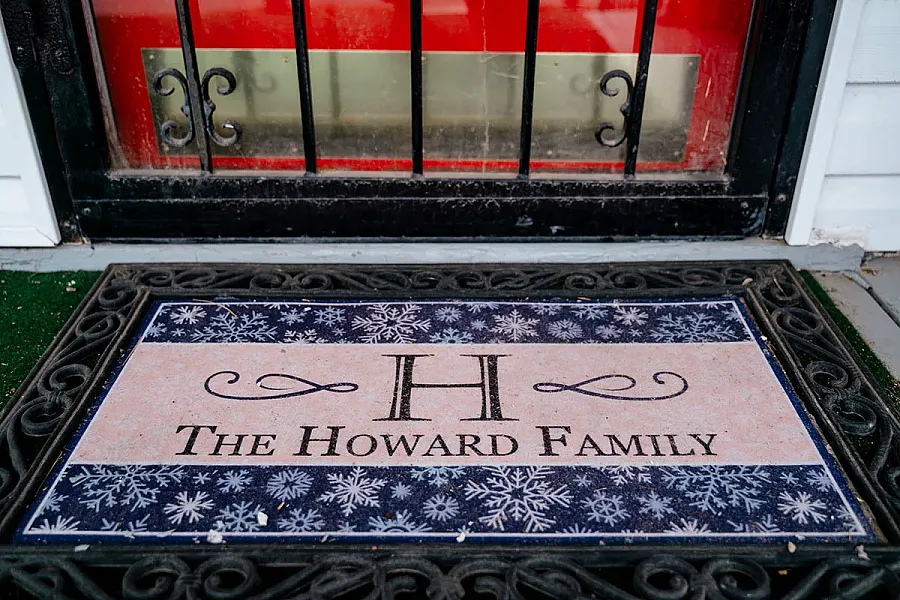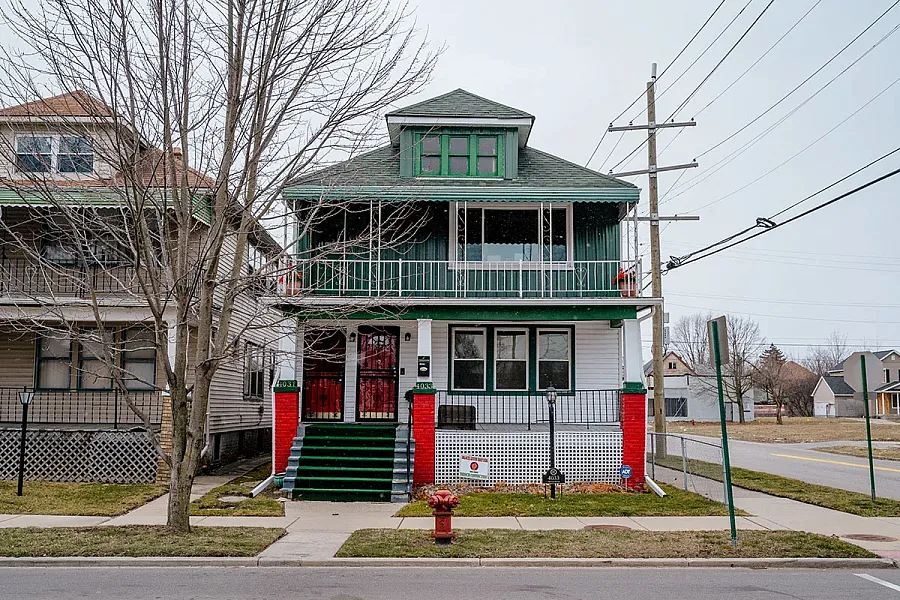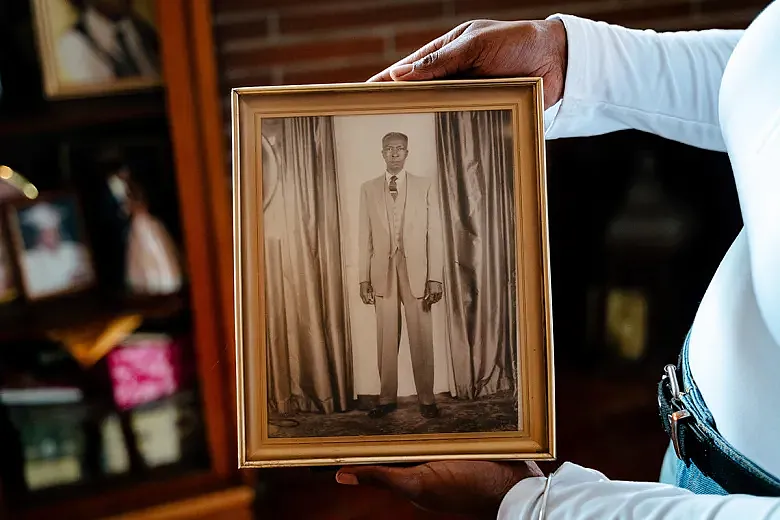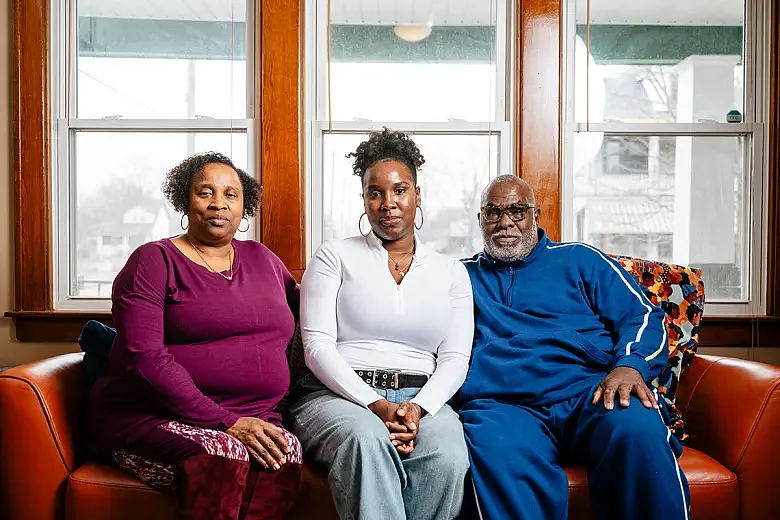Detroit’s cost for automotive growth: Generational displacement
The story was originally published in Bridge Detroit with support from our 2022 Data Fellowship.

Kathryn Douglas in her home in the East Canfield neighborhood. She has lived there since the 1940s, witnessing all the ways the neighborhood has changed over the decades due to automotive manufacturer Stellantis.
(Photo by Nick Hagen)
Bethany Howard’s family has lived in the same two-story house in Detroit’s East Canfield neighborhood for five generations.
A blue-and-salmon colored door mat on the front porch embossed with “The Howard Family” greets visitors at the home where Howard lives with her daughter upstairs and her parents downstairs. Her brother’s home is across the street. For more than half a century Howard’s family has lived, worked, and attended school in the neighborhood.

(Photo by Nick Hagen)
In elementary school, Howard’s friend, Karessa Craig, lived on St. Jean “in a beautiful yellow-and-brown house,” and between them, Damon J. Keith Elementary, the former school they both attended.
But Howard vividly remembers in the 1990s when Craig’s home was demolished, along with hundreds of others, to make way for an expansion of the nearby Chrysler automotive plant. The city bought out thousands of residents and took their homes using eminent domain, and the company turned the land into parking lots and empty lawns.
“That was the first like, ‘Who are these people? And why did they tear Karessa’s house down?’” Howard said of the company, which later became Fiat Chrysler Automobiles, and is known today as Stellantis.
Now, a generation later, history is repeating itself.
In 2019, the company announced plans to establish Detroit’s first new auto assembly line in three decades. The project came with the promise of thousands of local jobs and commitments from Detroit Mayor Mike Duggan that residents would not be pushed out. But four years in, pungent and foul odors emanating from the new Detroit Assembly Complex have sparked health complaints and calls from Detroit’s City Council for residential buyouts or home swaps.
For lifelong residents like Howard, it’s a realization of the fear that had been growing for years since witnessing the first displacement: that the company might one day take her home, too.
“Are they gonna just try to buy us all out? What am I supposed to do then?,” said Howard, 36. “Chrysler, FCA, Stellantis – they’ve always been a reason for constant change over here.”
Detroit was built largely by the massive growth of the automotive industry in the 20th century, becoming synonymous with “cars” and earning itself the moniker “The Motor City.”

Bethany Howard’s family has lived in Detroit’s East Canfield neighborhood for five generations. Today, she shares the family home with her parents and daughter. Her brother resides across the street. The family has lived, worked and attended school in the neighborhood for more than a half century.
(Photo by Nick Hagen)
In the early 1900s, Detroit was the 13th largest American city. By 1940, it had jumped to the fourth-largest, with the three biggest automotive manufacturers in the country, hundreds of parts and accessory suppliers and some of the first highways. In 1914, Henry Ford famously announced he would pay workers $5 a day, and in the 1930s auto workers unionized, negotiating for better pay and conditions, becoming pivotal leaders in the national labor movement. The promise of high-paying quality jobs attracted thousands of mostly Black migrants and some Mexican immigrants, many of whom couldn’t find jobs elsewhere. For those people, working in a car factory was a pathway to the middle-class, so they put their trust in the industry, settling their families in The Motor City for generations to come.

Bethany holds a photo of her great-grandfather, King Williams. Howard’s family still lives in the same house Williams bought when he first moved to Detroit from Mississippi.
(Photo by Nick Hagen)
But from the beginning, the auto industry has also failed Black Detroiters like Bethany Howard and her family over and over again through expansion into Black neighborhoods that led to forced displacement, air pollution, and the broken promise of jobs.
Since the company first established in Detroit in 1925, the city has given Stellantis more than 400 acres of land and spent nearly $700 million on home buyouts, site cleanup and land purchases in order to facilitate two major expansions, adjusted for inflation. The first resulted in the displacement of approximately 2,000 residents, according to reporting from local newspapers at the time. The exact acreage is likely higher, but neither Stellantis nor the city had complete records of the 1980s deal. Meanwhile, the latest expansion has advocates and neighbors questioning the true benefit for Detroiters, arguing that the increased air pollution and health risks for hundreds of Black Detroiters are a clear example of environmental racism.

Bethany Howard lives with her daughter and parents in a house that’s been the family for five generations.
(Photo by Nick Hagen)
“This facility should have never been permitted to expand into the backyard of residents based on emissions alone,” said Andrew Bashi, an attorney representing east side residents in a civil rights complaint filed with the Environmental Protection Agency claiming that the state discriminated against Black residents in approving the permit.
“They have been disproportionately exposed to harms posed by industrial pollution,” he said. “Now they live with some of the highest levels of asthma and lowest average life expectancy in the state. If this isn’t a case of environmental racism I don’t know what is.”
A century-long toxic relationship
Nearly a hundred years ago, Walter P. Chrysler took over the former Maxwell Motor Company plant on Detroit’s east side and formed Chrysler Corporation.

Priscilla, Bethany, and Vanzell Howard pose for a photo on their couch in the home that’s been in their family for five generations.
(Photo by Nick Hagen)
Soon after Chrysler bought the plant across the street. Decades later, the company linked the two with a bridge, and became one of the largest auto manufacturers in the country. In the 1940s the company became central to Detroit’s role in World War II, producing engines and air raid sirens. But in the next few decades the company faced financial trouble and the pressures of globalization and suggested it might close the Detroit plant. In 1979, the company received the first of two bailouts from the federal government and kept the plant open, but cut its workforce. What followed was a cycle of job cuts, financial incentives and bailouts, followed by the promise of more jobs.
Their story is not unusual in Detroit.
A BridgeDetroit analysis of Detroit’s historic and current automotive factories found most were built in neighborhoods of color that were historically redlined by the government, subjecting those residents to disproportionate amounts of air pollution.
In the 1930s, the federal government drew red lines around neighborhoods it felt were too risky for mortgage loans; the basis was often whether people of color lived there. The practice, called redlining, systematically denied residents in those areas access to resources and investment and combined with racial covenants, prevented many from moving elsewhere. Today, the same neighborhoods are more likely to suffer disproportionately from air pollution, extreme heat, flooding, lower home values, and other negative impacts.
Detroit has three active automotive factories left; two belong to Stellantis and all three are in formerly redlined neighborhoods. The factories were the cause of air pollution, and displacement.
In the late 1980s, Chrysler began to force residents out when it announced plans for a $1 billion assembly facility in Detroit, next to its original plant. The project was expected to keep thousands of jobs, but it came at a cost: More than 20 blocks west of the site would need to be demolished to make room for the facility.
The city got to work under the Coleman Young Administration, assembling properties, demolishing more than 600 homes, displacing thousands of residents, and razing 150 businesses. Meanwhile, Stellantis, then Chrysler, was granted hundreds of millions of dollars in subsidies from the city and state, in addition to the millions from the city coffers.
Kathryn Douglas has lived in the east side neighborhood since the late 1940s. She is president of the neighborhood block club and a part-time social worker at the Barack Obama Leadership Academy, four streets over from Stellantis. Her husband worked at Chrysler Corporation, before retiring a little more than a decade ago. Now, her nephew works at the Stellantis Detroit plant.
Douglas said she first hoped that the automaker would improve the area. But over time, she said she wonders if Stellantis has brought more harm than good. While thankful for the jobs, she said she expected more community engagement.
“Initially, we expected them to really help the community to grow,” said Douglas. “It did not.”
Accounts of resident response varied, according to archived reporting from the Detroit Free Press. The city claimed most residents were happy with the buyouts, while others attributed the lack of complaints to poverty in the neighborhood and legal inexperience. Homeowners were denied copies of the city’s appraisal to negotiate for better deals and at least a few hundred residents and businesses were unhappy with the compensation they were offered. But under state law, the city was able to take the properties anyway, and sort out the details later. The factory, Jefferson North Assembly Plant, was created, and the original plant from the early 1900s was demolished.

The Chrysler footprint in 1949, compared to present day. In 1940, the Chrysler plant took up 47 acres, according to ‘Autopia’s End: The Decline and Fall of Detroit’s Automotive Manufacturing Landscape.’ Today, the assembly complex, including Jefferson North and Mack, spreads across 461 acres, according to the Stellantis website.
Historical photo from Wayne State University Libraries Digital and present day screenshot from Google Earth.
Douglas said a tall dirt barrier that Chrysler constructed in the ‘90s around its new facility blew particles and dust into the air and years passed before the company listened to the community.
Douglas said she wanted – and expected – greenspace, a walking path or engagement with the neighborhood from Stellantis during both of its major expansions, to benefit residents.
Today, Douglas partially attributes the factory’s presence to a gradual decline in the neighborhood and a lack of resources.
“Their impact has made a big difference in the landscape of what’s here and what’s not here,” she said.
Douglas, nearing 70, said she’s watched the neighborhood turn from “once very thriving” to “now pretty much a desert,” except for Stellantis, which “brings in lots of traffic, debris, and general health concerns.”
She said she’s watched the neighborhood lose its schools, pharmacies, and laundromats, leaving just one doctor’s office and a few churches.
“They’re used to be 98 houses on this block, there are now probably 40,” she said. “There’s no real thriving in the community, it just exists.”
When the city used eminent domain, Michigan’s Court of Appeals called the displacement of residents “unconscionable” but affirmed the trial court’s ruling in favor of it, citing the city’s earlier use of eminent domain in Poletown to give land to General Motors Co. for a factory.

Kathryn Douglas is the president of her her block club and a part-time social worker at a school four blocks from the automotive plant. Her husband retired from Chrysler just over a decade ago and her nephew now works for Stellantis. She once had hopes that the automaker’s growth would help the community, but feels now that it has not.
(Photo by Nick Hagen)
Today, Jefferson North manufactures the Jeep Grand Cherokee and Dodge Durango. Sitting adjacent is the Detroit Assembly Complex at Mack, the plant that has sparked new calls for buyouts. Meanwhile, a portion of the land where houses once stood is empty grass lawns, parking lots, and a U.S. Border Patrol station.
Now, Black residents are facing displacement by Stellantis, again. In February, in response to ongoing complaints, Detroit’s City Council passed a resolution calling for the city or state to offer residents buyouts.
Some have already been displaced.
After her son started having severe asthma attacks, Akishia Hunter moved them into a hotel. To spend time with her grandchildren, Tanisha Burton rents hotel rooms outside the neighborhood. And Binh Phung, who owns a house right across from the plant, hasn’t lived in it for the last several years, instead staying in a small apartment with a relative in Chicago.
Phung relocated when the plant expansion began in 2019, adding noise and dust. At that same time, Phung found out that his wife was pregnant.
“It put a lot of stress on me – I didn’t like the idea of having to live there with all this dust and noise,” said Phung, who is one of five residents in the civil rights complaint.
They moved to Chicago with plans to return when the construction stopped, but now, his daughter is 2 and Phung said he doesn’t know when he’ll feel it’s safe to move back.
Phung said a buyout would be helpful for neighbors like himself who want to stay in Detroit, but don’t want to live in the area and deal with the odors.
“I’m happy because finally there’s some hope the city council [will] start to listen to us,” he said.
In Detroit, many past buyouts have been tied to the automotive and transportation industry. In the 1960s, hundreds of Black-owned businesses were displaced by a highway built through a thriving epicenter of Black life. More than 4,000 residents were displaced from a similarly thriving neighborhood in Poletown to make way for a General Motors factory that opened in 1981. More recently, 70 families in Delray affected by the construction of the Gordie Howe International Bridge have been bought out, as were other Southwest Detroit families near the Marathon Petroleum Co. refinery. In all instances, the majority of the people displaced were residents of color.
Impacts unknown
Detroit is part of a region that until this year did not meet federal air quality standards because of high levels of ozone pollution, so the U.S. Environmental Protection Agency (EPA) prohibited activities that would significantly add ozone emissions. But Stellantis was able to open its new plant in the primarily Black, lower-income Detroit neighborhood because state regulators approved a plan to cut emissions at another one of its plants in Warren – a more affluent neighborhood.
Before the permit was granted in 2019, residents pleaded with the state to deny it. Among their concerns was that the neighborhood already faced high levels of asthma and pollution. But the state approved it, requiring additional air monitoring and community benefits to address the public health concerns.
By the end of construction, the factory would practically touch the backyard of residents on Beniteau Street.
The Michigan Department of Health and Human Services (MDHHS) told BridgeDetroit that it estimates at least 188 parcels of land in Detroit are impacted by the Stellantis plant odors, based on air sampling results from the department and the EPA, citizen complaints, and satellite imagery. But the number of impacted residents could be much more.
“We were only able to provide a rough estimate of the number of parcels in the area,” Lynn Sutfin, MDHHS public information officer, said in an email. The parcels, she noted, aren’t a direct representation of how many Detroiters might be impacted because each parcel could be occupied by more than one resident and “wind direction” could affect others beyond the areas surveyed.
After the permit was approved, the Great Lakes Environmental Law Center filed a civil rights complaint through the EPA against Michigan’s Department of Environment, Great Lakes, and Energy, alleging that the department’s approval of the permit was discriminatory.
In March, federal officials visited Stellantis and the surrounding neighborhood to hear directly from residents regarding the civil rights complaint.
A final ruling on the complaint is pending, but Bashi said, “We feel that the EPA has been taking our concerns really seriously.”
Historically, only 10% of civil rights complaints filed with the EPA are investigated, according to a report from the Center for Public Integrity and only a few times in history has the EPA issued a finding of noncompliance with the civil rights law.
Air around the community ‘is safe’
Over the years, Stellantis officials have said and continue to maintain that the emissions do not pose an increased risk to nearby residents. But the facility has been ticketed with eight air quality violations since 2021; the most recent in May.
Most of the facility’s violations are for odors, which can cause headaches and nausea and indicate the presence of potentially harmful chemicals in the air. One violation was issued for emitting more volatile organic compounds (VOCs) – a pollutant released when paint is applied to vehicles – than permitted. VOCs have been linked to eye, nose, and throat irritation, worsened asthma, and emerging research links the pollutant with adverse birth outcomes.
In response, Stellantis officials have said that the odors will be resolved when the company installs a new pollution control device, and in the meantime, the company has been using interim odor controls. Under a consent order with the state, Stellantis has until June 30 to install the device. But, at the same time, the company recently requested to increase its emissions – in some cases doubling them.
All the while the factory has been allowed to continue operating with a $5,000 fine as the only monetary enforcement, while responsibility gets punted from the city to the state.
The city orchestrated the land swaps and gave money to Stellantis to expand, but officials from the mayor’s office say they have no legal authority over air pollution coming from the plant.
“The Mayor’s office continues to advocate to the state on behalf of residents for a solution to the odor issue. This is entirely a state regulatory matter,” Duggan spokesperson John Roach told BridgeDetroit.
As for talk of buyouts, the mayor’s office says the present situation is different from in the past. Roach stressed in an email to BridgeDetroit that “not a single resident” was bought out or displaced within the 200 acres of land assembled for the plant’s most recent expansion. “It was all vacant land, some with vacant buildings,” he said.
EGLE said that Stellantis’ permit to increase emissions is still pending.
“Certain emission limit increases may be warranted, but any change in emissions must still comply with all applicable state and federal rules and regulations,” Jill Greenberg, EGLE spokesperson said by email.
“We understand the community’s concerns and have been responsive to concerns raised by the community near the Stellantis facility,” she said.

A residential block on the city’s east side near the Stellantis facility. The plant has received numerous violations since its expansion in recent years and neighbors frequently raise concerns over the pollution and odors.
(Photo by Nick Hagen)
EGLE has taken steps to address the concern, she said, including keeping affected neighbors informed on inspections, sampling and creating a dedicated webpage for Stellantis. Additionally, the department investigates and responds to odor complaints, and works with MDHHS regarding public health concerns. MDHHS conducted air sampling near the facility in November and December 2021.
“EGLE does not have the authority to require a company to do home buyouts,” Greenberg said. The only way EGLE can direct Stellantis money to benefit the community is through a voluntary supplemental environmental project, which has to be connected to an enforcement order, according to Greenberg.
Late last year, Stellantis agreed to an enforcement order with EGLE to address the repeated violations. The order required them to pay $136,832 to the state’s general fund and do one environmental project, which was to invest money into a local high school.
Bashi, the attorney advocating for the neighborhood, argues that the city is intentionally displacing residents to make way for Stellantis to further expand, a pattern seen in other instances across the city.
He pointed to land acquired in 2019 by the billionaire Moroun family in exchange for giving Stellantis land. A concrete facility was built on the property, directly across from residents who said they were being intimidated by a Moroun-owned company to move, with no help from the city.
In the law center’s complaint, lawyers sought buyouts and home repair for residents, and for cumulative impact to be considered by the state when issuing air permits. The complaint noted if buyouts were to occur they must be voluntary and it was of “utmost importance” that the land go into a community trust to prevent further industrial development.
“Thousands have been systematically displaced by expansion after expansion. Their limited greenspaces have been leveled and given away to Stellantis only to be turned into parking lots,” said Bashi. “Really, this is just the latest brick in a menacing wall built through decades of racism and the targeted pillaging of Black communities.”
Marcia Black, director of Black Bottom Archives, a community-driven organization for the preservation of local Black history and voices, said in situations where development is inevitable or has already happened, she hopes residents will be given adequate resources to ensure a just process.
“We are in a position where people should be given fair compensation, should be given some say-so and a little bit more agency in this type of process to make sure that we’re not replicating some of the harms that have happened from other development projects that have meant the displacement of Black communities historically, but also other communities,” she said.
Stellantis declined to respond to claims of environmental racism.
Job promises
At multiple points in history the city, state, and federal government have obliged Stellantis’ requests to give the company what it has needed to stay in Detroit, sacrifices made in large part to preserve and create jobs. But the Detroit workforce tied to the latest expansion and the longevity of the jobs is debatable.
When Stellantis expanded it promised to bring 4,000 new jobs to the plant, and to hire Detroiters first in an agreement with the city under a community benefits ordinance. So the city rushed to put together the land that the company wanted, in the narrow timeframe Stellantis mandated, and combined with the state, gave them nearly $400 million in tax incentives. The city and company said the expansion would bring good paying, high quality jobs for Detroiters.
“That’s what they promised us,” said Vanzell Howard, Bethany Howard’s brother, who lives a short walk from the factory.
It was later revealed that a portion of those new jobs were transfers, and some, like Vanzell Howard, were hired for positions at the Warren factory. Howard said he was placed at the Warren factory without benefits, and paid $15.50 an hour.
Stellantis reports that they’ve hired double the amount of Detroiters that they agreed to, but declined to answer how many Detroiters still hold those jobs.
“Stellantis is very proud of the fact that we have hired more than 8,800 Detroiters since June 2019 to work at our Mack Assembly Plant as well as our other plants throughout Michigan,” Stellantis spokesperson, Jodi Tinson, told BridgeDetroit in an email.
“We remain committed to offering any Detroiter interested in working for Stellantis an opportunity to make a good living and be part of our history in the Motor City,” Tinson wrote.
The longevity of the jobs is also uncertain. Metro Detroit has seen a 40% decrease in auto manufacturing jobs between 2001 and 2017. Investments in electric vehicles has meant more cuts, too.
In April, Stellantis offered buyouts to 33,500 of its workers. It spared its Detroit factories from cuts so far, but reduced the workforce by 3,200 employees at plants in Illinois and Italy in the last year, citing electric vehicle investment.
“While there always will be critics, we believe that this was a great deal for the city, as the new assembly plant alone has generated the 4,000 jobs promised and every new line worker hired at the plant to date is resident of the city of Detroit,” Roach said.
So far, Bethany Howard has been able to stay in her home. She lives slightly outside of the area the health department identified as affected by the smell, so she’s unsure if she would be offered a buyout. Even so, she worries if Stellantis will eventually expand into her neighborhood, taking her house that was passed on to her from her great-grandfather. The Stellantis facility is just a few blocks from Howard and can be seen from her front lawn.
“I don’t want to be bought out. I’m not letting anybody buy this house from me,” she said. “It’s a literal heirloom.
